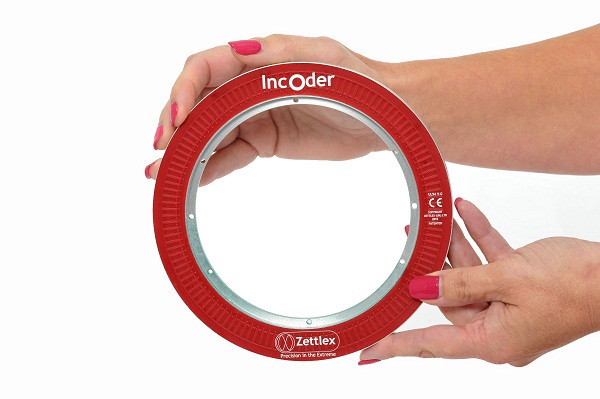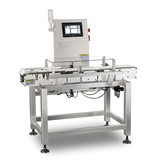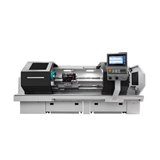With such a bewildering array of options, it can be difficult to select the most appropriate instrument for a specific application.
Step 1 in selecting the right sensor is to be clear about the requirements, particularly resolution, repeatability and linearity. Over-specifying will cause unnecessary expense.
Step 2 is to have a basic understanding of the sensor's operating principles, as these dictate the inherent strengths and weaknesses of any instrument. The following provides a description of the most common principles and their relative merits.
Potentiometers – the benchmark
Despite the trend towards non-contact sensors, potentiometers (‘pots') remain very common and provide a useful benchmark. Pots measure a voltage drop as a contact(s) slides along a resistive track. These sensors are widely available, compact and light. A simple device will cost less than £1, whereas a precision instrument may cost more than £100. Pots operate well in applications with modest duty cycles and benign environments. Unfortunately, pots are susceptible to wear and foreign matter. Higher quality devices quote long life, but this ignores vibration cycles.
Strengths: Low cost; simple; compact; lightweight. Can be made accurate.
Weaknesses: Susceptible to wear; vibration; foreign matter; extreme temperatures.
Optical
Optical sensors are also common, ranging from simple devices that cost less than £10 through to precision units costing in excess of £1,000. Their basic principles are similar: light is shone through or onto a grating and the resulting signals used to calculate position. Packaged, rotary encoders are widely available with 100-5,000 counts per revolution. Failures occur if the lens or grating become obscured by foreign matter.
It is important to note that if the encoder specifies 1,000 counts per revolution, this does not mean that it is accurate to 1/1000th of a revolution. Data sheets need to be carefully analysed, particularly for unpackaged encoders, which require accurate installation. Most units offer limited shock resistance.
Strengths: High resolution; good accuracy if mounted precisely; wide availability.
Weaknesses: foreign matter; catastrophic failure; shock; extreme temperatures.
Magnetic
Magnetic sensors all use a similar principle: as a magnet moves relative to a detector, the field changes. Magnetic sensors overcome many of the drawbacks of optical devices, as they are tolerant to foreign matter, but they are rarely used for precision applications due to hysteresis. Data sheets need careful analysis with respect to temperature coefficients and the effects of nearby materials or electrical sources.
Strengths: Fairly robust; most liquids have no effect.
Weaknesses: Temperature; hysteresis; precision mechanical installation; nearby steel/DC sources and poor impact/shock performance.
Magnetostrictive
These sensors use a phenomenon called ‘magnetostriction'. When a magnet approaches certain materials it causes energy passing along the material to reflect. Position can be measured from the time a pulse of energy takes to move through a strip of magnetostrictive material. The delicate strip must be carefully held in a wave guide and so shock or vibration is often problematic. Each sensor needs calibrating by the manufacturer, making magnetostrictive sensors relatively expensive.
The technique is sensitive to other influences – most notably temperature. Magnetostrictive data sheets often quote accuracy at constant temperature.
Strengths: Robust; well suited to high pressures; per cent accuracy increases with length.
Weaknesses: Relatively expensive; temp. effects; inaccurate over short distances (<100mm).
Capacitive
A capacitor is a device that accumulates charge. Typically, it has two conductive plates separated by an insulator. The stored charge varies with the size of the plates, their overlap, separation and permeability of the material between the plates. In its simplest form, a capacitive sensor measures plate separation. Displacements are usually <1mm for load, strain and pressure measurement. Another form uses plates that are cut or etched along the measurement axis. As another plate moves across them, capacitance varies, indicating position.
Capacitance also varies with temperature, humidity, nearby materials and foreign matter, which is why capacitive devices are seldom used in safety-related applications.
Strengths: Compact; low power.
Weaknesses: Large temperature and humidity coefficients; sensitive to foreign matter.
Traditional inductive
Linear inductive sensors are referred to as variable reluctance or linearly variable differential transformers (LVDTs). Rotary forms are known as synchros or resolvers. These work on inductive or transformer principles. As a magnetically permeable element moves, it varies inductance or transformer coupling. In LVDTs and resolvers, the ratio of the induced signals indicates position and this ratiometric technique is the key to their performance and solid reputation.
Whereas optical or magnetic sensors require electronics adjacent to the sensing point, inductive sensors can use remote electronics in benign condition with the sensor located in harsh environments.
Strengths: High accuracy; reliable; robust; extreme environments; widely available.
Weaknesses: Expensive; bulky; heavy.
New generation inductive
New generation inductive sensors – such as those made by Zettlex - use the same principles as traditional inductive sensors, offering good, non-contact performance in harsh environments. Rather than bulky transformer constructions, these sensors use printed circuits. The transition to printed windings brings other advantages:
- Reduction in cost, size and weight
- Greater flexibility in form factor
- Eradication of inaccuracy from the winding process
- Complex measurement geometries such as curvilinear, 2D and 3D sensing
Multiple sensors can be co-located using multi-layer circuit boards (for example, redundant sensors in safety applications).
EMC performance is generally as good as resolvers or LVDTs.
Strengths: High accuracy; reliable; robust; multiple geometries; compact; lightweight; resilient in harsh environments.
Weaknesses: More expensive than potentiometers.











-160x160-state_article-rel-cat.png)

-160x160-state_article-rel-cat.png)


-160x160-state_article-rel-cat.png)



